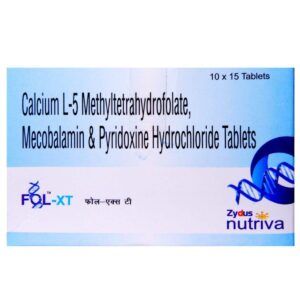PYRIODOXINE + HYDROCHLORIDE + METHYCOBALAMIN
Pyriodoxine: Pyridoxine is a drug that belongs to the vitamin B6 family. It is an essential nutrient that plays a vital role in various bodily processes, including metabolism, red blood cell production, and neurotransmitter synthesis. Pyridoxine is commonly used as a dietary supplement to treat or prevent vitamin B6 deficiency.
The mechanism of action of pyridoxine involves its conversion into its active form, pyridoxal phosphate (PLP). PLP acts as a coenzyme in many biochemical reactions, particularly those involving amino acids. It is required for the metabolism of proteins, carbohydrates, and fats. Additionally, pyridoxine is involved in the synthesis of neurotransmitters such as serotonin, dopamine, and GABA, which are crucial for proper brain function.
Pyridoxine is available in various dosage forms, including oral tablets, capsules, and liquids. The typical recommended dose for adults is around 1.3-1.7 mg/day. However, the dosage may vary depending on the individual’s age, sex, and specific health conditions. It is important to follow the dosing instructions provided by the healthcare professional or mentioned on the product label.
Most people can tolerate pyridoxine without any notable side effects when taken at appropriate dosages. However, taking high doses of pyridoxine (above the recommended daily intake) for a prolonged period of time can lead to adverse effects. Some potential side effects of excessive pyridoxine intake include nerve damage (peripheral neuropathy), sensory neuropathy, and skin lesions.
It is important to consult with a healthcare professional before starting pyridoxine supplementation, especially if a person has any underlying medical conditions or is taking other medications. The healthcare provider can suggest the appropriate dosage and monitor for any potential interactions or adverse effects.
Hydrochloride: Hydrochloride is not a specific drug name but rather a salt form commonly used in pharmaceuticals. It refers to the hydrochloride salt of a drug, which is added to improve stability and bioavailability.
To provide a more comprehensive answer, here’s an example drug that utilizes the hydrochloride salt form: Sertraline Hydrochloride, also known by the brand name Zoloft.
Use:
Sertraline Hydrochloride is primarily prescribed as an antidepressant within the selective serotonin reuptake inhibitor (SSRI) class. It is used to treat various mental health conditions, including major depressive disorder, panic disorder, obsessive-compulsive disorder, social anxiety disorder, and post-traumatic stress disorder.
Mechanism of Action:
Sertraline works by inhibiting the reuptake of serotonin, a neurotransmitter in the brain. By increasing the levels of serotonin in the synaptic cleft, it enhances neurotransmission and improves mood.
Dose:
Dosage of sertraline hydrochloride varies depending on the specific indication and individual patient characteristics. Common initial doses for adults range from 50 to 100 mg once daily for depression and anxiety disorders. The dosage may be adjusted by a healthcare professional based on the patient’s response and tolerance.
Side Effects:
Like any medication, sertraline hydrochloride may cause side effects. Common side effects include nausea, diarrhea, insomnia, dizziness, dry mouth, and sexual dysfunction. These side effects are usually mild and temporary, but if they persist or worsen, it is important to consult a healthcare provider.
Sertraline hydrochloride may also have some rare but serious side effects, such as suicidal thoughts, allergic reactions, and serotonin syndrome, especially when combined with other medications that increase serotonin levels. It is vital to seek immediate medical attention if any unusual or severe side effects occur.
It is important to note that the above information is specific to sertraline hydrochloride as an example drug. Different drugs using hydrochloride as a salt form may have distinct uses, mechanisms of action, dosages, and side effects. It is crucial to consult a healthcare professional or refer to the specific drug’s prescribing information for accurate and current information.
Methycobalamin: Methycobalamin is a form of vitamin B12 that is used to treat vitamin B12 deficiency. It is available in tablet, capsule, or injectable form.
The mechanism of action of methycobalamin is related to its role in the synthesis of DNA, red blood cells, and myelin sheath, which surrounds and protects nerve fibers. It acts as a cofactor in various enzymatic reactions, promoting the conversion of homocysteine to methionine. Methycobalamin is also involved in the regeneration of damaged nerves and may have neuroprotective effects.
The usual recommended dose of methycobalamin is 1,000-2,000 mcg per day for adults. The dosage may vary depending on the individual’s condition and the severity of the deficiency. For injected forms, a healthcare professional typically administers the dose.
Common side effects of methycobalamin are generally mild and may include nausea, diarrhea, headache, itching, and skin rash. These side effects are usually temporary and tend to subside on their own.
In rare cases, hypersensitivity or allergic reactions can occur, leading to symptoms such as swelling of the face, tongue, or throat, difficulty breathing, or severe dizziness. If any of these severe side effects occur, immediate medical attention should be sought.
It is important to note that methycobalamin should be used under medical supervision, as its administration may require proper monitoring of blood counts and periodic assessment of vitamin B12 levels.
Overall, methycobalamin is an essential vitamin B12 supplement that can effectively treat and prevent vitamin B12 deficiency, which can cause anemia and neurological problems. It is imperative to consult a healthcare professional for the appropriate dosage and to discuss any potential interactions with other medications or underlying health conditions.

